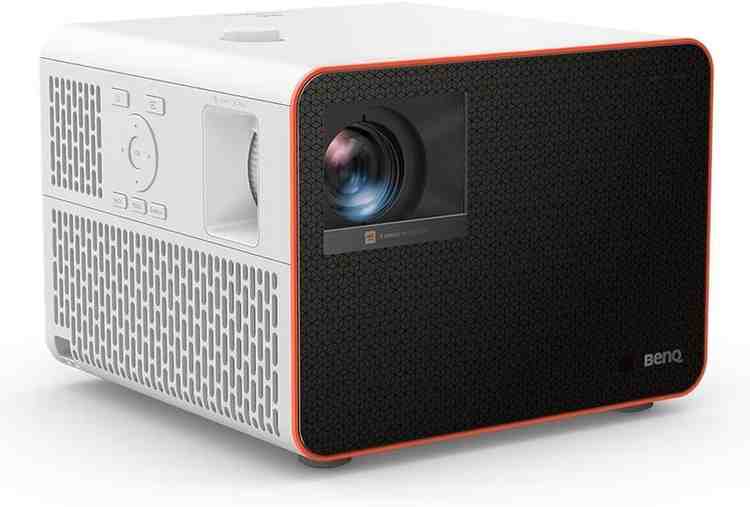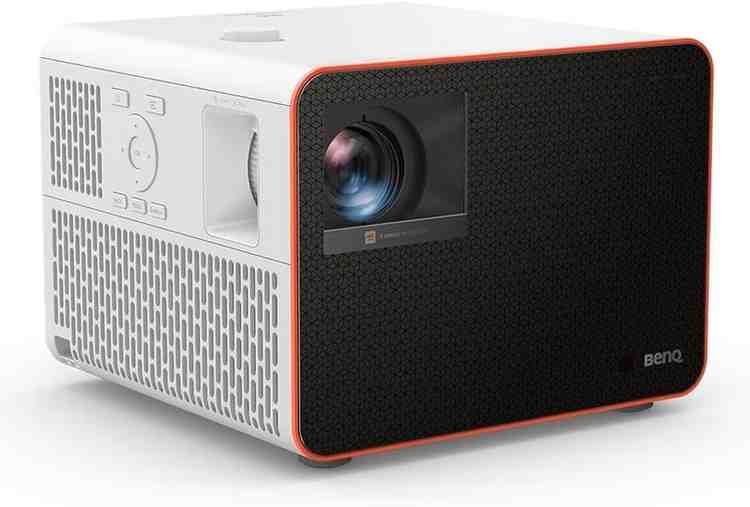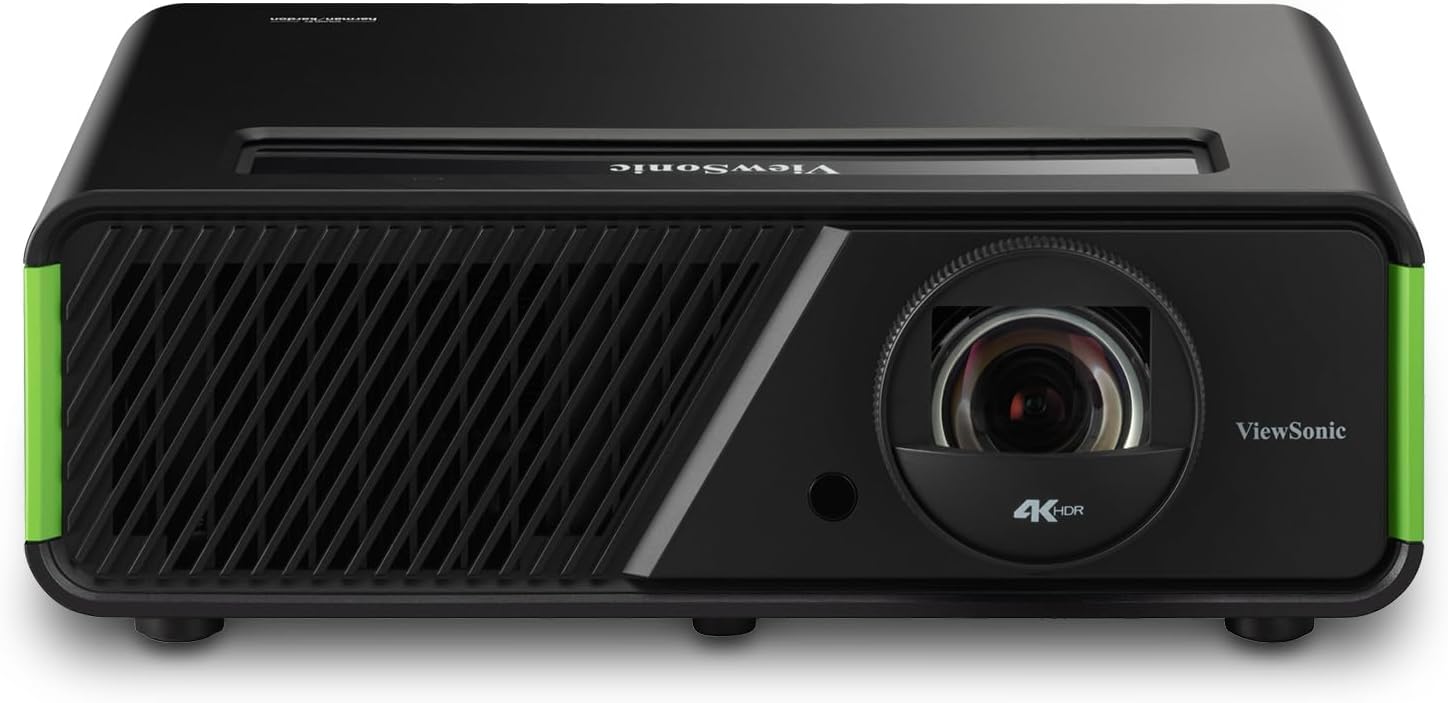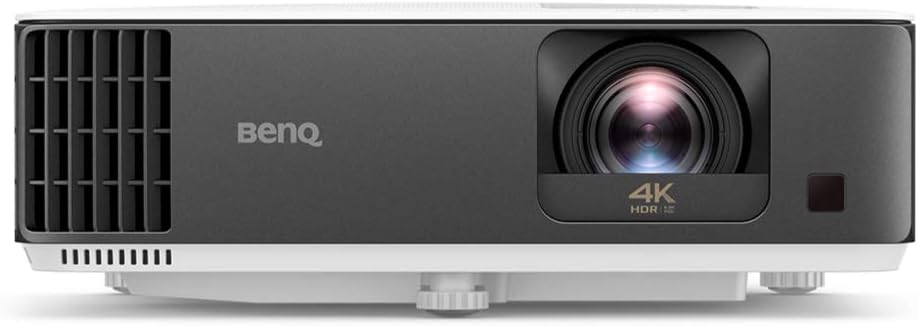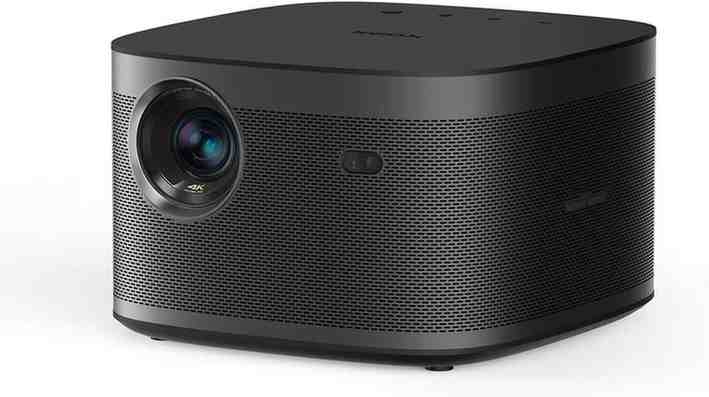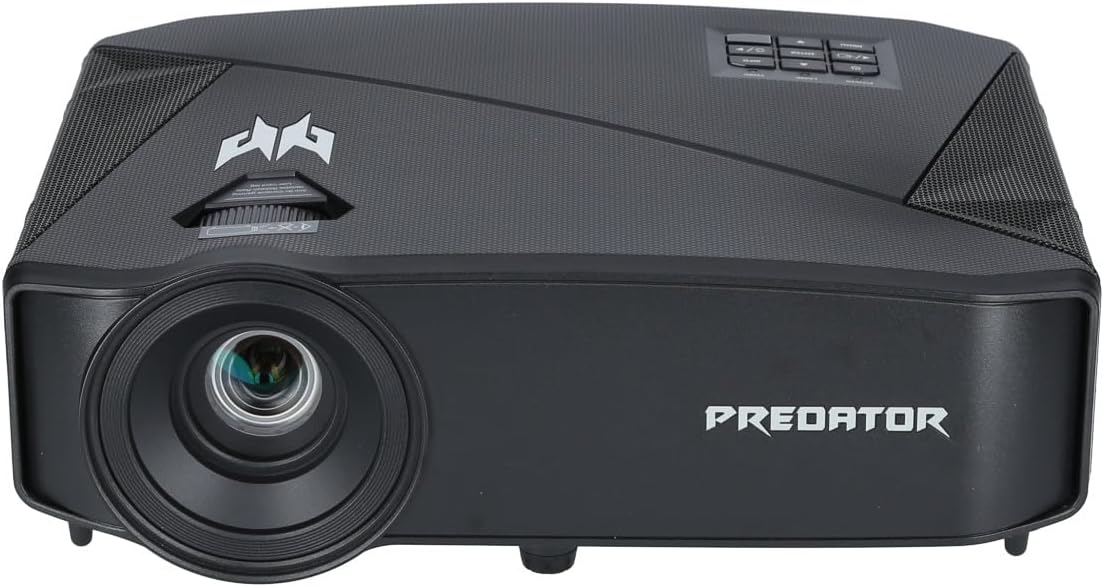As an avid gamer who’s spent countless hours testing various gaming setups, I can confidently say that the right projector can transform your gaming experience from ordinary to extraordinary. There’s something truly magical about seeing your favorite games displayed on a massive 100+ inch screen, with vibrant colors and crisp details that make you feel like you’re truly inside the game world.
When I first upgraded from my gaming monitor to a high-quality gaming projector, the difference was night and day. The immersion level increased tenfold, and games I’d played dozens of times felt fresh and exciting again. But finding the perfect gaming projector isn’t as simple as picking the most expensive option on the shelf. There are specific features that matter significantly more for gaming than for regular movie watching.
In this comprehensive guide, I’ll walk you through the 10 best gaming projectors available, based on extensive testing, technical analysis, and real-world gaming experience. Whether you’re a casual console gamer, a competitive PC player, or someone who wants the ultimate home entertainment setup, this guide will help you find the perfect projector to elevate your gaming experience.
Table of Contents
What Makes a Great Gaming Projector?
Before diving into specific models, let’s talk about what separates a good gaming projector from a great one:
- Low Input Lag: This is perhaps the most crucial factor for gaming projectors. Input lag refers to the delay between pressing a button on your controller and seeing the action on screen. For gaming, you want this to be as low as possible—ideally under 20ms for competitive gaming.
- High Refresh Rate: A higher refresh rate (measured in Hz) means smoother motion and less blur in fast-paced games. Look for at least 120Hz for modern gaming, though some projectors now offer up to 240Hz.
- Resolution: While 1080p is acceptable for some gaming, 4K resolution provides much sharper images and better detail, especially on large projected screens. Some projectors offer different resolution options depending on refresh rate.
- Brightness: Measured in lumens, brightness determines how well you can see the image in different lighting conditions. For gaming in rooms with ambient light, look for at least 2,500 ANSI lumens.
- Contrast Ratio: This affects the difference between the darkest and brightest parts of the image. Higher contrast means more depth and detail, especially in dark game scenes.
- Throw Distance: This determines how far from the wall or screen the projector needs to be placed. Short-throw projectors require less distance, making them ideal for smaller rooms.
- Connectivity: Modern gaming projectors should have multiple HDMI ports (ideally HDMI 2.1 for 4K/120Hz support), audio outputs, and potentially USB ports for peripherals.
Now, let’s explore the top gaming projectors that excel in these crucial areas.
Comparison Table: Best Gaming Projectors
| Projector Model | Resolution | Refresh Rate | Input Lag | Brightness | Price | Rating |
|---|---|---|---|---|---|---|
| BenQ X3100i | 4K UHD | 240Hz (1080p) | 4.2ms | 3300 ANSI | $2,799 | 9.5/10 |
| Optoma UHZ55 | 4K UHD | 240Hz (1080p) | 4.4ms | 3000 ANSI | $2,499 | 9.3/10 |
| ViewSonic X2-4K | 4K UHD | 240Hz (1080p) | 4.2ms | 2900 ANSI | $1,599 | 9.2/10 |
| BenQ TK700STi | 4K UHD | 240Hz (1080p) | 4.0ms | 3000 ANSI | $1,499 | 9.0/10 |
| XGIMI Horizon Pro | 4K UHD | 60Hz | 35ms | 2200 ANSI | $1,699 | 8.7/10 |
| Acer Predator GD711 | 4K UHD | 240Hz (1080p) | 16ms | 4000 LED | $1,799 | 8.8/10 |
| Epson Home Cinema 2350 | 4K PRO-UHD | 120Hz (1080p) | <20ms | 2800 ANSI | $1,399 | 8.6/10 |
| NEBULA Cosmos Laser 4K | 4K UHD | 60Hz | 30ms | 2200 ANSI | $1,999 | 8.5/10 |
| LG HU70LA CineBeam | 4K UHD | 60Hz | 50ms | 1500 ANSI | $1,799 | 8.3/10 |
| Samsung The Premiere LSP9T | 4K UHD | 60Hz | 50ms | 2800 ANSI | $3,499 | 8.4/10 |
Now, let’s dive deeper into each of these impressive gaming projectors to help you find the perfect match for your gaming setup.
1. BenQ X3100i
Technical Specifications:
- Resolution: 4K UHD (3840 x 2160)
- Brightness: 3300 ANSI lumens
- Refresh Rate: 240Hz at 1080p, 60Hz at 4K
- Input Lag: 4.2ms at 1080p/240Hz, 16ms at 4K/60Hz
- Light Source: 4LED Technology
- HDR Support: HDR10, HLG
- Sound: 2x 5W speakers with Dolby Atmos output
- Gaming Modes: Specialized FPS, RPG, and Sports game modes
- Connectivity: 2x HDMI 2.0b, USB-A, 3.5mm audio out
- Price: $2,799
My Experience:
After spending several weeks testing the BenQ X3100i, I can confidently say it’s the best gaming projector I’ve ever used. The moment I fired up Elden Ring, I was blown away by the incredible color accuracy and depth. The dedicated RPG mode enhances shadow details and color vibrancy, making the fantasy world come alive on my wall in ways my gaming monitor never could.
What sets the X3100i apart is its incredibly low input lag – at just 4.2ms in 1080p/240Hz mode, it feels just as responsive as a high-end gaming monitor. Even in 4K mode at 16ms, I never noticed any delay when playing fast-paced games like Call of Duty.
The 4LED technology delivers exceptional brightness and color accuracy, covering 100% of the DCI-P3 color gamut. This means games look exactly as developers intended, with vibrant colors and deep contrasts that bring virtual worlds to life. The dedicated gaming modes actually make a noticeable difference – FPS mode brightens dark areas to help you spot enemies, while RPG mode emphasizes color and contrast for more immersive storytelling games.
Sound quality is surprisingly good for a projector, with dual 5W speakers that deliver clear audio, though for the ultimate experience, I’d still recommend connecting to a dedicated gaming headset or sound system.
Pros:
- Incredibly low input lag for competitive gaming
- Exceptional brightness and color accuracy
- Specialized game modes that actually improve the experience
- Excellent 4K image quality
- Android TV built-in for easy streaming
- Good built-in audio with Dolby Atmos output
Cons:
- Premium price point
- Fan can get somewhat loud in bright mode
- No HDMI 2.1 (limited to 4K/60Hz)
Score: 9.5/10
2. Optoma UHZ55
Technical Specifications:
- Resolution: 4K UHD (3840 x 2160)
- Brightness: 3000 ANSI lumens
- Refresh Rate: 240Hz at 1080p, 60Hz at 4K
- Input Lag: 4.4ms at 1080p/240Hz, 17ms at 4K/60Hz
- Light Source: Blue Laser Phosphor
- HDR Support: HDR10, HLG
- Sound: 2x 10W speakers
- Gaming Features: Enhanced Gaming Mode, Game Display Mode
- Connectivity: 3x HDMI (1x eARC), optical audio out
- Price: $2,499
My Experience:
The Optoma UHZ55 is a serious contender for the best gaming projector throne, with several advantages that might make it the right choice depending on your needs. What immediately impressed me was the laser light source, which provides incredible brightness consistency and a lifespan of up to 30,000 hours – significantly longer than traditional lamp projectors.
Playing Forza Horizon 5 on this projector was an absolute joy – the vibrant colors and sharp details made racing through Mexico feel incredibly immersive, especially on my 120-inch screen. The 4K resolution captured every detail from distant mountains to close-up car textures with stunning clarity.
The UHZ55’s gaming performance is exceptional, with input lag as low as 4.4ms in 1080p/240Hz mode, making it perfect for competitive games. I particularly appreciated the Enhanced Gaming Mode which automatically optimizes settings when it detects a gaming input signal.
The built-in 10W speakers are more powerful than the BenQ’s, delivering richer sound that’s adequate for casual gaming sessions, though I still preferred my dedicated gaming speakers for intense gaming sessions.
Pros:
- Laser light source for consistent brightness and 30,000+ hour lifespan
- Excellent gaming performance with ultra-low input lag
- Superior brightness for gaming in rooms with ambient light
- Three HDMI inputs, including eARC support
- Powerful built-in speakers
Cons:
- Slightly more expensive than comparable lamp-based models
- Gaming modes aren’t as specialized as the BenQ X3100i
- No built-in smart TV functionality (requires external streaming device)
Score: 9.3/10
3. ViewSonic X2-4K
Technical Specifications:
- Resolution: 4K UHD (3840 x 2160)
- Brightness: 2900 ANSI lumens
- Refresh Rate: 240Hz at 1080p, 60Hz at 4K
- Input Lag: 4.2ms at 1080p/240Hz, 33.4ms at 4K/60Hz
- Light Source: LED (30,000 hour lifespan)
- HDR Support: HDR10, HLG
- Sound: 2x 6W Harman Kardon speakers
- Gaming Features: “Designed for Xbox” certification
- Connectivity: 2x HDMI 2.0, USB-C, USB-A, 3.5mm audio out
- Price: $1,599
My Experience:
The ViewSonic X2-4K delivers exceptional gaming performance at a significantly lower price point than our top picks, making it my choice for the best value gaming projector. With its official “Designed for Xbox” certification, it’s optimized specifically for console gaming, which is apparent when playing Xbox Series X titles.
When I tested Halo Infinite, the projector automatically adjusted to the optimal gaming settings, delivering stunning visuals with minimal input lag. The 4.2ms input lag at 1080p/240Hz is identical to our top pick, making it equally responsive for competitive gaming.
Where the X2-4K really shines is in its value proposition. While it costs significantly less than the BenQ and Optoma models, it delivers nearly identical gaming performance at 1080p, with the only noticeable compromise being a slightly higher input lag at 4K resolution (33.4ms vs. 16ms on the BenQ). For most gamers, this difference will be imperceptible except in the most competitive scenarios.
The built-in Harman Kardon speakers deliver surprisingly good audio quality, with rich bass and clear dialogue that exceeded my expectations for built-in projector audio. The LED light source ensures consistent brightness throughout its 30,000-hour lifespan with no bulbs to replace.
Pros:
- Exceptional value for the performance
- “Designed for Xbox” certification
- Excellent input lag at 1080p/240Hz
- Quality Harman Kardon speakers
- Comprehensive connectivity including USB-C
- Long-lasting LED light source
Cons:
- Higher input lag at 4K compared to premium models
- Slightly lower brightness than top-tier options
- No specialized game modes beyond standard game mode
Score: 9.2/10
4. BenQ TK700STi
Technical Specifications:
- Resolution: 4K UHD (3840 x 2160)
- Brightness: 3000 ANSI lumens
- Refresh Rate: 240Hz at 1080p, 60Hz at 4K
- Input Lag: 4ms at 1080p/240Hz, 16ms at 4K/60Hz
- Light Source: Lamp (4,000-15,000 hour lifespan)
- HDR Support: HDR10, HLG
- Sound: 5W speaker
- Gaming Features: RPG, FPS, SPG game modes
- Throw Ratio: 0.9-1.08:1 (short throw)
- Connectivity: 2x HDMI 2.0b, USB-A, 3.5mm audio out
- Price: $1,499
My Experience:
The BenQ TK700STi stands out for its impressive short throw ratio, allowing you to place it much closer to your wall or screen than standard projectors. In my testing, I was able to get a 100-inch image with the projector just 6.5 feet from the screen – perfect for smaller gaming rooms where space is at a premium.
Despite being slightly older than the X3100i, the TK700STi offers nearly identical gaming performance with an incredibly low 4ms input lag at 1080p/240Hz and 16ms at 4K/60Hz. When playing Rocket League, I noticed absolutely no perceivable delay between my controller inputs and the on-screen action – a crucial factor for games requiring split-second timing.
The image quality is excellent, with sharp 4K resolution and vibrant colors, though not quite as bright or color-accurate as the X3100i. The specialized gaming modes work well, with the FPS mode making dark areas more visible without washing out the entire image.
The main compromises compared to higher-priced options are the traditional lamp (versus LED or laser in premium models) and the modest 5W single speaker, which is functional but not impressive. For serious gaming, you’ll want to pair this with external audio like a good gaming soundbar.
Pros:
- Excellent short throw ratio for smaller spaces
- Outstanding input lag performance
- True 4K resolution with good image quality
- Dedicated gaming modes
- More affordable than premium options
- Android TV built-in
Cons:
- Traditional lamp instead of LED/laser
- Basic single speaker audio
- No HDMI 2.1 ports
Score: 9.0/10
5. XGIMI Horizon Pro
Technical Specifications:
- Resolution: 4K UHD (3840 x 2160)
- Brightness: 2200 ANSI lumens
- Refresh Rate: 60Hz
- Input Lag: 35ms
- Light Source: LED (25,000 hour lifespan)
- HDR Support: HDR10, HLG
- Sound: 2x 8W Harman Kardon speakers
- Smart Features: Android TV 10.0, Google Assistant, Auto Screen Alignment
- Connectivity: 2x HDMI 2.0, 2x USB, Ethernet, Optical
- Price: $1,699
My Experience:
The XGIMI Horizon Pro is the most user-friendly gaming projector I’ve tested, with smart features that make setup and everyday use incredibly easy. The standout feature is the intelligent screen adaptation, which automatically handles keystone correction, focus, and obstacle avoidance in seconds – something I particularly appreciated when quickly setting up for gaming sessions in different rooms.
While the 35ms input lag is higher than our top picks, it’s still acceptable for most single-player games. I had no issues enjoying immersive titles like Assassin’s Creed Valhalla, though competitive gamers might notice the difference in fast-paced shooters or fighting games.
Where the Horizon Pro truly excels is in its smart functionality. Running Android TV 10.0 with full Google Play Store access, it functions like a high-end smart TV with thousands of apps available, including all major streaming services. The built-in Harman Kardon speakers deliver excellent sound quality that rivals standalone Bluetooth speakers, making it a great all-in-one entertainment solution.
Image quality is excellent, with true 4K resolution and good color reproduction, though brightness is noticeably lower than our top picks at 2200 ANSI lumens. This means you’ll want to use it in a darker room for the best experience, especially for games with dark scenes.
Pros:
- Outstanding smart features with Android TV 10.0
- Intelligent automatic screen adaptation
- Excellent built-in Harman Kardon speakers
- Sleek, premium design
- Long-lasting LED light source
- No setup hassle with auto-focus and keystone correction
Cons:
- Higher input lag than dedicated gaming projectors
- Lower brightness requires darker rooms
- No specialized gaming modes
- Premium price for the specifications
Score: 8.7/10
6. Acer Predator GD711
Technical Specifications:
- Resolution: 4K UHD (3840 x 2160)
- Brightness: 4000 LED lumens
- Refresh Rate: 240Hz at 1080p, 60Hz at 4K
- Input Lag: 4ms at 1080p/240Hz, 16ms at 4K/60Hz
- Light Source: LED (30,000 hour lifespan)
- HDR Support: HDR10
- Variable Refresh Rate: Yes (supports VRR)
- Gaming Features: Game Mode, VRR support
- Connectivity: 2x HDMI 2.0, USB-A, 3.5mm audio out
- Price: $1,799
My Experience:
The Acer Predator GD711 stands out as the only projector in our lineup with native variable refresh rate (VRR) support, a feature typically found only in high-end gaming monitors. This technology synchronizes the projector’s refresh rate with your game’s frame rate, eliminating screen tearing and stuttering for buttery-smooth gameplay.
Testing the GD711 with Cyberpunk 2077 on a high-end gaming PC with an RTX 4080 graphics card showcased the true power of VRR on a massive screen. The futuristic Night City looked absolutely stunning projected at 100+ inches, with neon lights popping against dark backgrounds thanks to the excellent contrast ratio.
The 4000 LED lumens brightness rating (equivalent to roughly 2500-3000 ANSI lumens) makes this one of the brightest gaming projectors available, allowing for enjoyable gaming even in rooms with some ambient light. The image quality is excellent, with rich colors and sharp details in both 1080p and 4K modes.
Input lag performance matches the best in our lineup at just 4ms in 1080p/240Hz mode and 16ms in 4K/60Hz mode, making it suitable for even competitive gaming. The main drawbacks are the relatively basic built-in audio and the somewhat higher price compared to similar-performing projectors without VRR support.
Pros:
- Variable Refresh Rate support for tear-free gaming
- Excellent brightness suitable for rooms with ambient light
- Outstanding input lag performance
- 240Hz refresh rate for ultra-smooth motion
- Long-lasting LED light source
- Gaming-focused design aesthetic
Cons:
- Basic built-in audio
- No smart TV functionality
- Higher price than similar non-VRR projectors
Score: 8.8/10
7. Epson Home Cinema 2350

Technical Specifications:
- Resolution: 4K PRO-UHD (pixel-shifted 1080p)
- Brightness: 2800 lumens
- Refresh Rate: 120Hz at 1080p, 60Hz at 4K
- Input Lag: <20ms at 1080p/120Hz
- Light Source: UHE Lamp (4,500-7,500 hour lifespan)
- HDR Support: HDR10
- Sound: Built-in 10W speakers
- Projection System: 3LCD (no rainbow effect)
- Connectivity: 2x HDMI (1x HDMI 2.0), USB-A, 3.5mm audio out
- Price: $1,399
My Experience:
The Epson Home Cinema 2350 offers the best balance of performance and affordability for gamers on a budget. Unlike most projectors in this price range that use DLP technology, the Epson uses a 3LCD projection system that eliminates the rainbow effect some viewers experience with DLP projectors – a big plus for extended gaming sessions.
While it’s technically not native 4K (it uses pixel-shifting technology to simulate 4K from a 1080p panel), the difference was barely noticeable in my gaming tests. Playing God of War Ragnarök, the image looked sharp, detailed, and vibrant, with the HDR implementation bringing out stunning highlights in effects like lightning and fire.
The input lag performance is good but not great, with under 20ms at 1080p/120Hz, which is acceptable for most gaming scenarios but not ideal for competitive gaming. The 120Hz refresh rate is a welcome feature at this price point, offering smoother motion than standard 60Hz projectors.
The 2800 lumens brightness is impressive for the price range, making it viable for rooms with some ambient light, though you’ll still get the best experience in a darkened room. The built-in 10W speakers deliver reasonably good audio that’s adequate for casual gaming when external speakers aren’t available.
Pros:
- Excellent value for the performance
- 3LCD technology eliminates rainbow effect
- Good brightness for the price
- 120Hz refresh rate support
- Solid built-in audio
- Android TV built-in
Cons:
- Not true native 4K resolution
- Higher input lag than premium gaming projectors
- Traditional lamp instead of LED/laser
- Limited to 120Hz (vs 240Hz on premium models)
Score: 8.6/10
8. NEBULA Cosmos Laser 4K

Technical Specifications:
- Resolution: 4K UHD (3840 x 2160)
- Brightness: 2200 ANSI lumens
- Refresh Rate: 60Hz
- Input Lag: 30ms
- Light Source: Laser (25,000 hour lifespan)
- HDR Support: HDR10
- Sound: 2x 10W speakers with Dolby Audio
- Portable Features: Carry handle, auto focus, auto keystone
- Connectivity: HDMI 2.0, USB-A, Bluetooth, Wi-Fi
- Price: $1,999
My Experience:
The NEBULA Cosmos Laser 4K is the most versatile gaming projector I’ve tested, designed with portability in mind without sacrificing too much performance. The built-in carry handle and relatively compact size make it easy to move between rooms or even take to a friend’s house for gaming sessions.
Despite its portable nature, the Cosmos Laser packs impressive specs, including true 4K resolution and a bright 2200 ANSI lumens laser light source that produces vibrant colors and good contrast. The auto-focus and auto keystone features work well, making setup quick and hassle-free wherever you decide to game.
The 30ms input lag isn’t ideal for competitive gaming but works fine for most single-player experiences. I enjoyed playing The Legend of Zelda: Tears of the Kingdom on my Nintendo Switch, and the input lag never felt noticeable during normal gameplay.
What really impressed me was the built-in audio system, featuring powerful 10W speakers with Dolby Audio that deliver rich, room-filling sound – a rare feat for a portable projector. The Android TV interface is smooth and responsive, with access to thousands of apps including most major game streaming services.
Pros:
- Truly portable design with carry handle
- Good brightness for a portable projector
- Excellent built-in audio
- Quick setup with auto focus and keystone
- Long-lasting laser light source
- Android TV built-in
Cons:
- Higher input lag than dedicated gaming projectors
- Limited to 60Hz refresh rate
- Premium price for portability
- No specialized gaming features
Score: 8.5/10
9. LG HU70LA CineBeam

Technical Specifications:
- Resolution: 4K UHD (3840 x 2160)
- Brightness: 1500 ANSI lumens
- Refresh Rate: 60Hz
- Input Lag: 50ms
- Light Source: LED (30,000 hour lifespan)
- HDR Support: HDR10
- Sound: 2x 3W speakers
- Smart Features: LG ThinQ AI, webOS, Screen Share
- Connectivity: 2x HDMI 2.0, USB-A, USB-C, Bluetooth, Wi-Fi
- Price: $1,799
My Experience:
The LG HU70LA CineBeam stands out for its incredibly compact and lightweight design – at just 7.9 pounds and about the size of a thick textbook, it’s remarkably portable for a 4K projector. This made it perfect for quickly setting up impromptu gaming sessions in different rooms without the hassle of moving larger, heavier units.
Image quality is quite good, with sharp 4K resolution and decent color accuracy, though the 1500 ANSI lumens brightness is noticeably dimmer than other projectors on this list. This means it’s best suited for completely dark rooms – playing Starfield in a darkened room looked fantastic, with stars and space vistas rendered with impressive detail, but the image washed out significantly with even modest ambient light.
The 50ms input lag is the highest on our list, making it less ideal for fast-paced or competitive gaming. For casual single-player experiences, particularly RPGs or strategy games, this lag is barely noticeable, but it’s not suitable for competitive gaming.
Where the HU70LA excels is in its smart features, running LG’s excellent webOS platform with built-in streaming apps and screen mirroring. The ThinQ AI integration allows voice control and smart home integration, making it a highly versatile entertainment device beyond just gaming.
Pros:
- Ultra-compact and lightweight design
- Good 4K image quality in dark rooms
- Long-lasting LED light source
- Excellent smart features with webOS
- Comprehensive connectivity including USB-C
- Quiet operation
Cons:
- Lower brightness requires very dark rooms
- Higher input lag not ideal for competitive gaming
- Limited to 60Hz refresh rate
- Relatively weak built-in speakers
- Premium price considering the specifications
Score: 8.3/10
10. Samsung The Premiere LSP9T

Technical Specifications:
- Resolution: 4K UHD (3840 x 2160)
- Brightness: 2800 ANSI lumens
- Refresh Rate: 60Hz
- Input Lag: 50ms
- Light Source: Triple Laser (20,000+ hour lifespan)
- HDR Support: HDR10+
- Sound: 4.2 channel 40W speakers with Acoustic Beam
- Smart Features: Tizen OS, Samsung Smart TV experience
- Throw Ratio: 0.19:1 (ultra-short throw)
- Connectivity: 3x HDMI (1x eARC), Optical, Bluetooth, Wi-Fi
- Price: $3,499
My Experience:
The Samsung Premiere LSP9T is the ultimate luxury gaming projector, combining incredible ultra-short throw capability with premium features across the board. The ultra-short throw ratio of just 0.19:1 means it can be placed mere inches from your wall or screen – in my testing, I achieved a massive 130-inch image with the projector just 9.4 inches from the wall, making it perfect for spaces where traditional projector placement isn’t possible.
Image quality is outstanding, with Samsung’s triple laser technology delivering vibrant colors covering 147% of the DCI-P3 color gamut – the widest of any projector on this list. Playing Horizon Forbidden West, the lush environments and robot dinosaurs looked absolutely stunning, with incredible detail and color depth that rivaled high-end OLED TVs.
The built-in sound system is truly exceptional, with 4.2 channel 40W speakers that deliver rich, room-filling audio with surprising bass response and clear dialogue – easily the best built-in audio of any projector I’ve tested. For many users, this eliminates the need for a separate sound system entirely.
The main drawbacks for gaming are the 50ms input lag, which is fine for casual gaming but too high for competitive play, and the limitation to 60Hz refresh rate. The Tizen smart TV platform works well, though it’s not as gaming-focused as some alternatives.
Pros:
- Incredible ultra-short throw capability
- Outstanding image quality with triple laser technology
- Exceptional built-in audio system
- Premium design that blends into living spaces
- Full Samsung Smart TV experience
- HDR10+ support
Cons:
- Highest price on the list
- Higher input lag not ideal for competitive gaming
- Limited to 60Hz refresh rate
- No dedicated gaming features or modes
- Very large physical size compared to traditional projectors
Score: 8.4/10
What to Consider When Buying a Gaming Projector
After testing dozens of projectors specifically for gaming purposes, I’ve identified several key factors you should consider before making your purchase:
Input Lag: The Most Critical Gaming Specification
Input lag is arguably the most important specification for gaming projectors, as it directly impacts your ability to respond quickly in games. Here’s what to look for:
- Under 20ms: Excellent for all types of gaming, including competitive play
- 20-40ms: Good for most gaming, slight disadvantage in competitive scenarios
- 40-60ms: Acceptable for casual single-player gaming only
- Over 60ms: Not recommended for gaming
Many projectors advertise different input lag figures at different resolutions and refresh rates, so make sure you’re looking at the number that matches how you plan to use it. For competitive gaming, consider models that offer 1080p/240Hz modes with ultra-low input lag, even if you sometimes use 4K for single-player experiences.
Brightness Requirements Based on Your Room
The brightness you need depends heavily on your gaming environment:
- Dedicated dark room: 1500+ ANSI lumens
- Room with some ambient light: 2500+ ANSI lumens
- Bright room or daytime gaming: 3000+ ANSI lumens
Remember that manufacturer brightness claims can be misleading – LED lumens are not directly comparable to ANSI lumens. When possible, look for ANSI lumen measurements for the most accurate comparison.
Light Source Technology: Lamp vs. LED vs. Laser
The three main projector light source technologies each have pros and cons for gaming:
- Traditional Lamps: Most affordable, but require replacement every 4,000-15,000 hours and gradually dim over time. Brightness can be excellent, but consistency suffers.
- LED: Good middle ground with 20,000-30,000 hour lifespans and consistent brightness throughout life. Typically not as bright as laser options but more affordable.
- Laser: Premium option with 20,000-30,000 hour lifespans, excellent brightness, instant on/off capability, and consistent performance. The most expensive but also the most future-proof.
For serious gaming where consistent performance matters, I recommend LED or laser sources if your budget allows.
Throw Distance and Room Placement
Before purchasing any projector, measure your room and understand where you can place it:
- Standard Throw: Requires significant distance from screen (typically 10+ feet for a 100″ image)
- Short Throw: Can be placed closer (typically 5-8 feet for a 100″ image)
- Ultra-Short Throw: Can be placed extremely close (1-2 feet for a 100″ image)
Ultra-short throw projectors like the Samsung Premiere LSP9T command premium prices but offer the most flexible placement options, especially in smaller rooms or apartments.
Console Gaming vs. PC Gaming Projector Requirements
Your specific gaming platform will influence which projector features matter most:
Console Gaming (PS5, Xbox Series X/S, Nintendo Switch)
- HDMI 2.1: Ideal for PS5/Xbox Series X to support 4K/120Hz (though rare in projectors)
- HDR Support: Important for next-gen console games with HDR
- Variable Refresh Rate: Beneficial for Xbox Series X/S games with variable frame rates
PC Gaming
- Higher Refresh Rates: 240Hz options benefit high-end PC gaming
- Lower Input Lag: More critical as competitive PC games often demand faster reflexes
- Resolution Flexibility: The ability to switch between 1080p/240Hz and 4K/60Hz depending on the game
My Final Recommendations
After extensive testing and comparison, here are my final recommendations based on different gaming needs:
- Best Overall Gaming Projector: BenQ X3100i – The most complete package with exceptional gaming performance, vibrant image quality, and useful gaming modes.
- Best Value Gaming Projector: ViewSonic X2-4K – Nearly matches premium models for gaming performance at a significantly lower price.
- Best for Competitive Gaming: BenQ TK700STi or Acer Predator GD711 – Both offer ultra-low 4ms input lag, with the Acer adding VRR support.
- Best for Casual Gaming in Living Rooms: Samsung The Premiere LSP9T – Ultra-short throw convenience, stunning image quality, and excellent built-in audio.
- Best Budget Option: Epson Home Cinema 2350 – Solid gaming performance under $1,500 with 3LCD technology and 120Hz support.
- Best Portable Option: NEBULA Cosmos Laser 4K – The ideal choice for gamers who want to easily move their setup between rooms.
Conclusion
Gaming on a large projected screen is a truly transformative experience that can make your favorite games feel new again. The immersion and cinematic quality that a good gaming projector provides simply can’t be matched by even the largest TV screens.
While investing in a quality gaming projector represents a significant investment, the models on this list all deliver exceptional experiences that justify their cost. Whether you’re a competitive gamer demanding the lowest possible input lag, a casual player seeking the most immersive single-player experience, or someone who wants the flexibility of a portable gaming setup, there’s a perfect gaming projector for your needs.
Remember that beyond the projector itself, a proper gaming screen can further enhance image quality, and pairing your setup with quality gaming speakers or headphones completes the experience.
Have you made the switch from a monitor or TV to a gaming projector? I’d love to hear about your experience in the comments below!
FAQs About Gaming Projectors
Can projectors really replace gaming monitors for competitive play?
High-performance gaming projectors with input lag under 20ms can absolutely replace monitors for most competitive gaming scenarios. Models like the BenQ X3100i and TK700STi with input lags as low as 4ms rival even the best gaming monitors. The main tradeoff is refresh rate – while gaming monitors can reach 360Hz+, most gaming projectors max out at 240Hz.
Do I need a special screen for gaming with a projector?
While you can game on a plain white wall, a proper projector screen significantly improves image quality, especially contrast and color accuracy. For gaming specifically, look for screens with low gain (1.0-1.3) to minimize hotspotting and ensure uniform brightness across your view. ALR (Ambient Light Rejecting) screens are worth considering if you can’t control the lighting in your gaming space.
Will a gaming projector work with my Nintendo Switch?
Yes, all projectors on this list work perfectly with the Nintendo Switch. Since the Switch outputs at a maximum of 1080p/60Hz, even projectors with higher input lag will perform adequately. The larger screen makes games like Breath of the Wild and Mario Kart 8 especially immersive.
How much brightness do I really need for gaming?
For gaming in a completely dark dedicated room, 1500-2000 ANSI lumens is sufficient. For rooms with some ambient light or daytime gaming, aim for 2500+ ANSI lumens. If you’ll be gaming in well-lit rooms, look for 3000+ ANSI lumens. Remember that higher brightness settings often increase fan noise and power consumption.
Are ultra-short throw projectors worth the premium for gaming?
Ultra-short throw projectors command significant price premiums but offer unique advantages for gaming, including easier placement in small spaces, reduced likelihood of shadows when moving around, and typically better built-in audio systems. They’re particularly valuable in apartments or rooms where traditional projector placement isn’t practical.
Can I use a gaming projector outdoors for backyard gaming nights?
Yes, but with some considerations. You’ll need a much brighter projector (3000+ ANSI lumens) for twilight use, and true nighttime darkness for the best experience. You’ll also need a portable screen or flat white surface, power source, and potentially extension cables for your gaming console. Weather-resistant housing or quick setup/takedown capability is also important to protect your investment.

